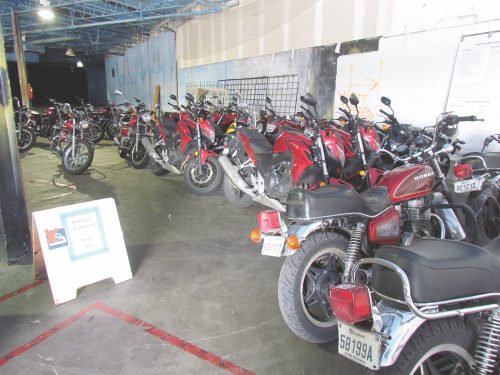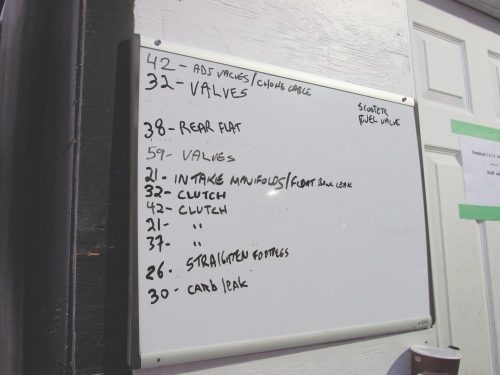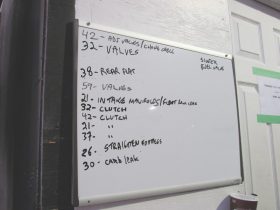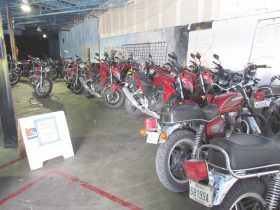Regular maintenance keeps the fleet running.
I never thought I’d be working as a paid mechanic again, yet here I am elbow-deep into an old Honda. It needs a fork seal, a valve adjustment, an oil change and a new rear tire. There are about a dozen more bikes lined up behind this one waiting for some kind of pressing service.
No, I haven’t taken on a full-time job in a motorcycle shop. My job as a licensed motorcycle instructor has recently expanded to include servicing the school’s fleet of hard-working Hondas. My new position came about with the recent acquisition of an enclosed storage area.
 Because there’s limited space in the city to set up a proper training facility, the riding school I work for used to store bikes in shipping containers. A recent vacancy in a building adjacent to our closed-course circuit provided the opportunity not only to store our motorcycles, but also to set up shop. There are, after all, more than 50 motorcycles that get a regular, abusive workout.
Because there’s limited space in the city to set up a proper training facility, the riding school I work for used to store bikes in shipping containers. A recent vacancy in a building adjacent to our closed-course circuit provided the opportunity not only to store our motorcycles, but also to set up shop. There are, after all, more than 50 motorcycles that get a regular, abusive workout.
I went through my inventory and put together a secondary toolbox (spending 20 years as a motorcycle tech usually means you gather more tools than you need) with all the basics, as well as a few specialized Honda tools. I also finally put to use an ancient motorcycle lift that I had put into storage more than 30 years ago. It’s a simple device made of wood that probably dates back to the early 1970s, and has a pivoting tabletop that you push the bike onto, pivot until it’s level, then lock into place with a steel pipe. It’s an archaic item that’s likely more suitable as a museum piece, and by today’s standards is entirely unsafe, but it places the bike to be worked a little more than a half-metre off the ground, for which my back is thankful. Lighting was inadequate, so a couple of portable, clip-on lamps provide additional illumination where needed.
 The fact that some of the bikes are more than 30 years old doesn’t make the job any easier. Most of the ones that do the hardest work – on the closed course, at low speeds – are early 1980s Honda CB450SC Nighthawks. The reason is simple: They are just about the toughest bikes for the job. These things were overbuilt, with robust clutches and solid gearboxes, and they’re easy to maintain. Valve adjustments are by screw and locknut, making it a half-hour job. When we used to store the bikes in the containers, I would perform the valve adjustments outdoors, but only when the weather was nice. Now I can do it any time.
The fact that some of the bikes are more than 30 years old doesn’t make the job any easier. Most of the ones that do the hardest work – on the closed course, at low speeds – are early 1980s Honda CB450SC Nighthawks. The reason is simple: They are just about the toughest bikes for the job. These things were overbuilt, with robust clutches and solid gearboxes, and they’re easy to maintain. Valve adjustments are by screw and locknut, making it a half-hour job. When we used to store the bikes in the containers, I would perform the valve adjustments outdoors, but only when the weather was nice. Now I can do it any time.
Despite the clutches being tough as nails, the almost daily abuse they receive by inexperienced hands takes a toll. Most of them last a couple of seasons, which is remarkable under the circumstances, but there are now about four bikes that move when cold but don’t once they warm up, and two that refuse to move regardless of engine temperature. Fortunately, all the parts needed are available through the aftermarket, and are very affordable.
Other issues we experience regularly, especially when the bikes come out of winter storage, are fuel leaks. While some originate at the petcock, most come from the carburetors, but not from overflow due to sticky float valves – we do, after all, take the proper pre-storage precautions by adding fuel stabilizer to the gas and draining the float bowls. The leaks come from the junction between the float bowl and carburetor body due to dried-out gaskets. Remarkably, and with the experiences to back me up, most of these types of leaks fix themselves after a few hours with gasoline in the float bowls, saving me the trouble of pulling the carbs. Tire pressures are checked and drive chains are lubed weekly, levers and gearshifters are straightened regularly, and there’s almost always a tire to change.
Some of the CB450s have been retired over the years, but they continue being useful by being cannibalized for parts. Replacing them with new ones is becoming difficult; some good, affordable used ones still appear in classified ads, and we quickly snap them up, but this new café racer craze is driving prices up, since CB450s are a popular choice among backyard builders.
Because the owner of the riding school has had such a great run with the old Hondas, two years ago, he began replacing the aging road bikes with brand-new CB500Fs (ironically, he rides a Yamaha). Being used solely on the road, these bikes have had an easy life so far, but they’re soon going to reach the mileage threshold that will graduate them to the closed course. Time will tell if they’re as tough as the CB450s, but in the meantime, I’m going to do my best to squeeze as much life from the aging twins as possible.
Technical articles are written purely as reference only and your motorcycle may require different procedures. You should be mechanically inclined to carry out your own maintenance and we recommend you contact your mechanic prior to performing any type of work on your bike.












